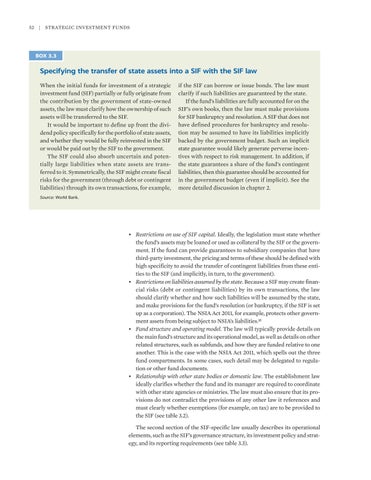52
| Strategic Investment Funds
BOX 3.3
Specifying the transfer of state assets into a SIF with the SIF law When the initial funds for investment of a strategic investment fund (SIF) partially or fully originate from the contribution by the government of state-owned assets, the law must clarify how the ownership of such assets will be transferred to the SIF. It would be important to define up front the dividend policy specifically for the portfolio of state assets, and whether they would be fully reinvested in the SIF or would be paid out by the SIF to the government. The SIF could also absorb uncertain and potentially large liabilities when state assets are transferred to it. Symmetrically, the SIF might create fiscal risks for the government (through debt or contingent liabilities) through its own transactions, for example,
if the SIF can borrow or issue bonds. The law must clarify if such liabilities are guaranteed by the state. If the fund’s liabilities are fully accounted for on the SIF’s own books, then the law must make provisions for SIF bankruptcy and resolution. A SIF that does not have defined procedures for bankruptcy and resolution may be assumed to have its liabilities implicitly backed by the government budget. Such an implicit state guarantee would likely generate perverse incentives with respect to risk management. In addition, if the state guarantees a share of the fund’s contingent liabilities, then this guarantee should be accounted for in the government budget (even if implicit). See the more detailed discussion in chapter 2.
Source: World Bank.
• Restrictions on use of SIF capital. Ideally, the legislation must state whether the fund’s assets may be loaned or used as collateral by the SIF or the government. If the fund can provide guarantees to subsidiary companies that have third-party investment, the pricing and terms of these should be defined with high specificity to avoid the transfer of contingent liabilities from these entities to the SIF (and implicitly, in turn, to the government). • Restrictions on liabilities assumed by the state. Because a SIF may create financial risks (debt or contingent liabilities) by its own transactions, the law should clarify whether and how such liabilities will be assumed by the state, and make provisions for the fund’s resolution (or bankruptcy, if the SIF is set up as a corporation). The NSIA Act 2011, for example, protects other government assets from being subject to NSIA’s liabilities.18 • Fund structure and operating model. The law will typically provide details on the main fund’s structure and its operational model, as well as details on other related structures, such as subfunds, and how they are funded relative to one another. This is the case with the NSIA Act 2011, which spells out the three fund compartments. In some cases, such detail may be delegated to regulation or other fund documents. • Relationship with other state bodies or domestic law. The establishment law ideally clarifies whether the fund and its manager are required to coordinate with other state agencies or ministries. The law must also ensure that its provisions do not contradict the provisions of any other law it references and must clearly whether exemptions (for example, on tax) are to be provided to the SIF (see table 3.2). The second section of the SIF-specific law usually describes its operational elements, such as the SIF’s governance structure, its investment policy and strategy, and its reporting requirements (see table 3.3).

